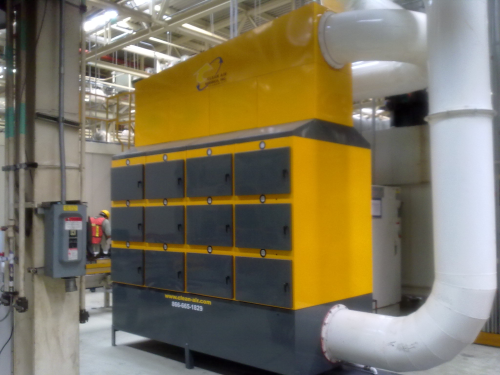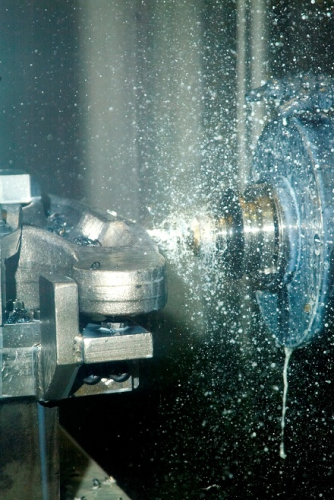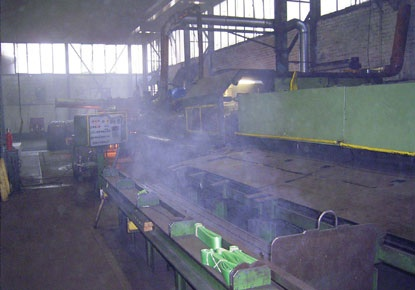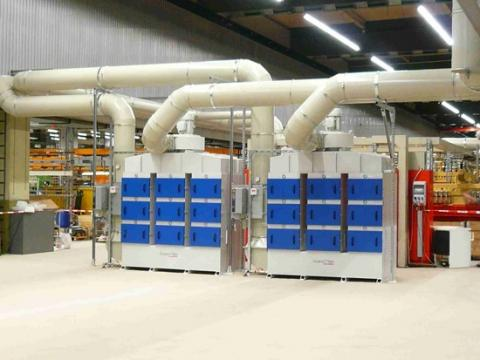



Modern manufacturing facilities contain equipment, such as machines for welding, grinding and cutting, along with CNC machine tools for turning, grinding and milling for example, that give off oil mist in the production environment when operating. These types of facilities include manufacturers of medical components and instruments, aerospace, automotive power train parts such as engines, transmissions and processes such as extrusions, hot presses with graphite oils, steel mills and others.
Oil mist and smoke gets into the environment and causes harm to equipment and workers. The risks that are most often associated with large concentrations of oil mist or oil smoke are the following:
• Oil mist can contain small metallic particles, bacteria and spores that can give rise to respiratory problems.
• Can cause skin problems, including oil acne and eczema.
• Increased risk of slipping - oil mist eventually settles on the floor.
• Oil mist accumulating on surfaces inside HVAC systems will impair its function, efficiency, filter life and will foul indoor air.
• Generally unclean environment due to the oil attracting other impurities causing them to stick to machines and other equipment.
• Oil mist harms the electronics in modern metalworking machines.
• Oil mist causes a ‘haze’ in the plant that can be unattractive to potential customers when they visit.
Oil mist and oil smoke is generated from a number of various manufacturing operations. Before we can take the correct measures to overcome the risks and harm that these substances cause, we need to know specifically what oil mist and oil smoke really are.
In the manufacturing industry, oil mist arises especially during metal-cutting machining, which is a comprehensive term for turning, milling, grinding and boring. Oil mist arises when oil or water mixed with concentrated cutting fluid, so-called emulsion, is used for cooling, lubricating or chip removal.
With high speed and pressure, the oil drops get very small (<1 µm) and the amount of oil in the air is often high. In some operations, oil smoke occurs in a larger scale.
As machining operations are carried out, these fluids are emitted in the form of aerosols and smoke to the surrounding air. It is, of course, unhealthy to breathe these substances.
Health and safety issues are now being taken very seriously by a growing number of companies. Many large US manufacturers are planning ahead and adopting European exposure limits as a global standard for their entire company and are exceeding OSHA Standards.
The exposure limits these companies are targeting range from 0.02-1 mg/m3 depending on company policy. Older old mist collector technology simply cannot provide these higher requirements.
The National Board of Occupational Safety and Health has therefore drawn up specific limit values for this. The current limit value for the emission of aerosols in industrial premises is 5 mg/m3.
Plus, the cost of energy is at an all-time high and continues to rise, so more and more companies are striving for energy efficiency. They may be using alternative fuels and energy-saving equipment, yet it is well known that air filters account for as much as 30% of the total energy consumption within air filtration systems. And these filtration systems are needed in heavy industrial and fabrication environments to keep workers breathing clean air. Selecting the correct filter that offers the best efficiency and lowest average pressure drop can create significant savings on energy while maintaining a healthy quality to indoor air.
Protecting workers' health from oil mist and oil smoke
The most common and effective method of collecting oil mist/oil smoke is at the source, i.e. directly at the metalworking machine. This is possible both in the case of completely enclosed machines and open machines. In an enclosed machine, negative air pressure is created in the space where the machining operations take place. The oil-laden air is sucked out of the enclosure and conveyed through a duct to the filter unit. After the air has been filtered, it is returned to the premises. If open machines are installed, it is common to try to capture oil mist/smoke in some kind of hood or superstructure and from there convey it through a duct to the filter unit.
Newer oil mist and oil smoke collector technology is available that removes oil mist and smoke from the machining floor environment and efficiently separates oil fumes, oil mist, oil smoke, oily dust, and emulsion mist and returns crystal clean air to the plant.
Oil mist, oil smoke and harmful particles such as swarf, bacteria and spores generated by metalworking machines are extracted at source and cleaned by more efficient coalescing (draining) technology. These newer model oil mist collectors utilise a 3-stage process where the first 2 stages are designed specifically either for emulsion or neat oil and the 3rd filter is a H13 HEPA (99.995%). With this high degree of separation and efficiency the cleaned air is then returned directly to the workshop, where it exceeds exposure limits set by OSHA, NIOSH and HSE.
Stage 1 - Oil coalescer filters
The oil removal filters operate by collecting the oil or coolant and allowing it to drain to the base of newer oil mist collection units. The filters do not ‘absorb’ the oil, but rather coalesce it until it is heavy enough to drain.
Contaminated air passes through the filter media. As it does so, the oil particles are attracted to the oleophobic fibres. The oil droplets continue to collide with the fibre, causing the oil droplets to gain in mass. As the oil drop becomes bigger, it becomes heavy enough to fall against the airflow to the base of the unit, where it can be collected or drained straight back to the machine tool sump.
Stage 2 - Oil removal filters
The ‘scrubbed’ air is then passed through a highly efficient coalescer at stage two where the coalescing process is repeated. After this second filtration stage, the air is on average 95-98% free from oil mist.
Stage 3 - HEPA filtration
The third filtration stage is designed to completely clean the remaining air to a standard far higher than the surrounding ambient air. Using a HEPA filter, this final stage ensures that fine, sub-micron particles (trace oil, smoke, bacteria, pollen and spores) are trapped and not allowed to return to the workshop.
HEPA (High-Efficiency Particulate Aerosol) filters have a minimum particle collection efficiency of 99.97% for particles 0.3 microns in diameter. HEPA filters (grade H13 EN1822) operate at 99.95% efficiency at 0.3µm. A micron is 1 millionth of a metre, or about 0.00003937 inches, which means there are 25,400 microns in an inch. The human eye can see particles as small as 10 microns.
This means that in a workshop environment, effectively all hazardous particles are trapped, ensuring only clinically clean air is returned to the workshop.
Also, new model oil mist collectors offer more than just health and safety resolution. They can improve productivity, lower numerous costs, and reduce energy consumption through a low maintenance and easy-to-install design.
Oil mist collectors – new versus old
A major automotive engine manufacturer, with arguably the most advanced plant in Europe, had issues with an existing, group-preferred oil mist system. Although these systems were only a couple of years old, the performance results came as a complete shock when surveyed.
Performance of the existing oil mist filtration system:
• Inlet: 5.790 mg/m³
• Outlet: 5.703 mg/m³
• Efficiency: 1.5%
Using a newer model oil mist collection and filtration system resulted in much improvement in performance:
• Inlet: 5.516 mg/m³
• Outlet: 0.034 mg/m³
• Efficiency: 99.3%
The reason the efficiency was not higher was because there was only space for two coalescing filter stages, not a stage 3 HEPA.
A standard three-stage oil mist collection unit, installed at a prestigious European engine manufacturer was attached by ducting to two Grob machines, which were machining cylinder heads using emulsion.
Over the three years that the test was conducted, no filter changes were required or performed. Performance numbers were:
• Average inlet: 28.3 mg/m³
• Average outlet: 0.001 mg/m³
• Efficiency: 99.999%
Based on these examples, utilising newer model, 3-stage filtration, oil mist collectors improves efficiency 100-fold. Plus, they help companies attain health, safety, and cleanliness standards, such as:
• Exceeds international health and safety standards.
• Achieves stringent controls.
• Improves cleanliness on the manufacturing floor.
• Mitigates slip hazards from oil mist.
• Increases workplace visibility and lighting.
• Improves productivity by requiring less maintenance and few filter changes.
• Improves environmental compliance and energy usage by recycling collected oil.





